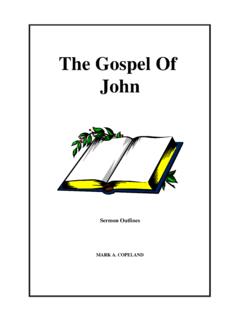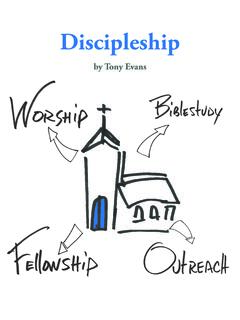Transcription of THE GOSPEL ACCORDING TO JOHN - s36550.pcdn.co
1 THE GOSPEL ACCORDING TOJOHNJohn wanted his readers to understand that Jesus was both divine and human, and that He is the source of salvation for all humankind. In the first chapter he introduced Jesus as the Word, who was with God in the beginning, who was God, and through whom creation happened (1:1 3). Each chapter of john s Gos pel references Jesus deity in some way. While stressing His divinity, john also highlighted Jesus humanity (1:14): we see one illustration of this when Jesus dear friend Lazarus died. Jesus showed His very human emotional capacity when His grief moved Him to tears (11:35).
2 john s GOSPEL is unlike the three Synoptic Gospels. While there is similarity among the first three, 90 percent of john s GOSPEL is unique. Rather than focus ing on what Jesus did, john wanted his readers to know what Jesus said and who Jesus was. john recorded long dialogues Jesus had with individuals, lengthy dis courses with crowds, and, perhaps most significantly, an extensive recounting of Jesus last words to His disciples before He went to the cross (chs. 13 17). john s GOSPEL provides details about Jesus ministry in Jerusalem and Judea rather than Galilee. Themes of contrast mark this book: light and darkness, life and death, belief and unbelief, love and hate, the eternal and that which four Gospels together describe dozens of miracles Jesus performed.
3 john described only seven of these. He referred to these miracles as signs because he wanted his readers to see that they pointed to the reality that Jesus was the Son of the end of his GOSPEL , john clearly stated his purpose for writing: to show that Jesus was truly the Christ and the source of human salvation (20:30 31). Once readers realized that Jesus was the Messiah, they could be drawn to belief in Him and have eternal I am statements make up another unique element in john s GOSPEL . In Moses encounter with the burning bush, God revealed himself as I am (Ex. 3:14). Jesus harkened back to the burning bush and revealed aspects of His divin ity in seven metaphoric statements.
4 Jesus declared, I am the bread of life (6:35, 48); I am the light of the world (8:12); I am the door (10:7, 9); I am the good shepherd (10:11, 14); I am the resurrection and the life (11:25); I am the way, the truth, and the life (14:6); and I am the true vine (15:1, 5). In addition to affirming His divinity, Jesus used these metaphors to indicate ways in which He was the ultimate solution to the human often spoke of His divinity in ways that drew deep resistance from the Jewish religious leaders. In chapter 2 john described how Jesus cleared the tem ple, which set the stage for the conflict with Jewish religious leaders that grew more intense with each encounter.
5 For those who did not believe, Jesus claims of divinity were blasphemous and called for his death. The conflict finally culmi nated in Jesus crucifixion. john presented Jesus as the Messiah whose words were clear only to those who believed in & LITERARY CONTEXTThis GOSPEL , like the others, is technically an anonymous work. But in the second century, church father Irenaeus promoted the view that john was the author of the fourth GOSPEL . Internal evidence supports this view. For example, the author had inti mate knowledge of the Jewish feasts and customs.
6 He also described events from an eyewitness perspective and related geo graphic details about the settings of events. The fact that john s name does not appear in this GOSPEL when john was one of the three prominent disciples Jesus often took aside for significant experiences ( , Mark 5:37) seems to indicate that he was the author. Note several references to one of His disciples , whom Jesus loved (13:23). It seems reasonable that the author might not include his own name in his writing while suggesting that he was the disciple who had this special status with Jesus.
7 john was one of the first disciples Jesus called with the words Follow Me (Matt. 4:19). He and his brother, James, were fishermen and identi fied as sons of Zebedee and called the Sons of Thunder (Mark 3:17).Scholars debate when john wrote this GOSPEL . The traditional view puts the date of writing between the middle and the end of the first s GOSPEL is an invitation to explore how Jesus presented Himself as both divine and human in ways that inspire belief leading to eternal life. As mentioned, much of john s GOSPEL is a record of extended faith nurturing conversations Jesus had with individuals and His disciples .
8 As you read, notice how Jesus established rapport with individuals and how He stretched their thinking about theological ideas in ways that fostered growing belief in example, in the conversation with Nicodemus the Pharisee, note how Jesus introduced the idea of spiritual birth (3:1 21). Feel the confusion Nicodemus must have felt. As you read about the Samaritan woman at the well (4:1 42), marvel at the theological depth of the conversation Jesus initiated with this woman, and note the transformation that resulted. Pay attention to the conversations that reveal the reli gious leaders growing resentment of Jesus (chs.)
9 7 10). Be impressed with the way Jesus interacted with Mary and Martha after their brother, Lazarus, died. Note the faith state ments from these sisters (ch. 11). Reflect on the significant postresurrection conver sations Jesus had with grieving Mary Mag dalene; Thomas, who dared to express his doubt (ch. 20); and Peter, who needed res toration following his denial of Jesus (ch. 21).Spend extended time in Jesus last words with His disciples in the Upper Room as they celebrated the Passover before His arrest, trial, and crucifixion (chs. 13 17). Jesus laid foundations in these words that the apostles echoed later in their writings.
10 Think about the following themes in the Upper Room Discourse: love as the mark of the Christian community, the promise and gift of the Holy Spirit, fruitfulness in the life of a follower of Jesus, promised comfort during coming persecution, and the promise of eternal life. Jesus gave His disciples what they needed to live faithfully after He was you read and engage with john s Gos pel, meet Jesus. Welcome Him. Be prepared to grow in your appreciation of Christ s humanity and divinity in ways that will sup port your deepening IntroductionTHE ETERNAL WORD1In the beginning was the Word, and the Word was with God, and the Word was God.






